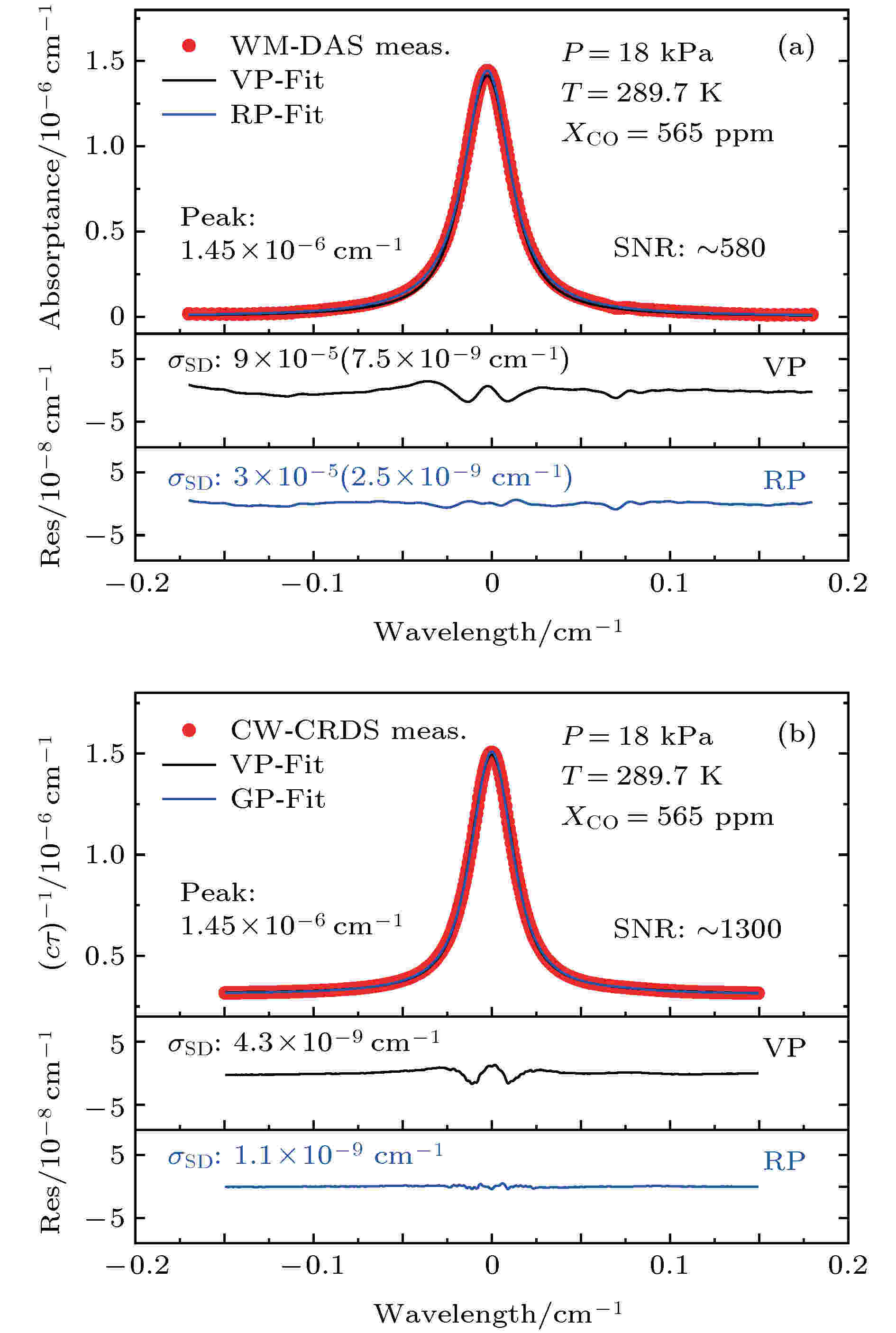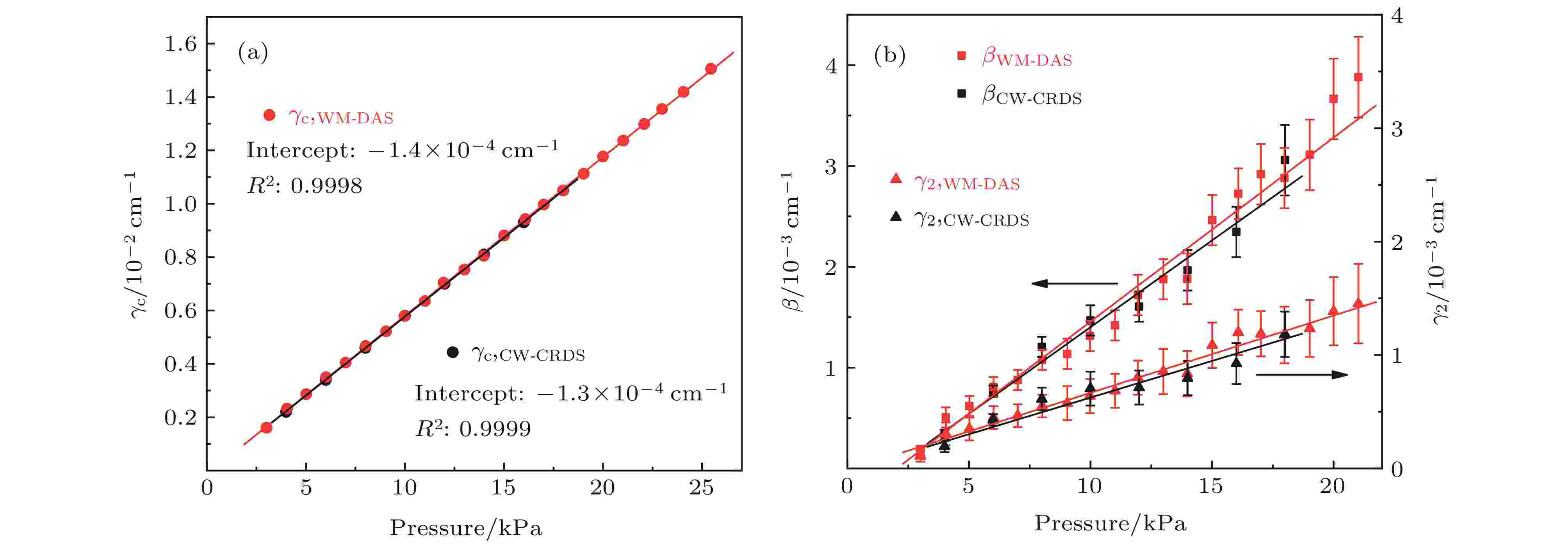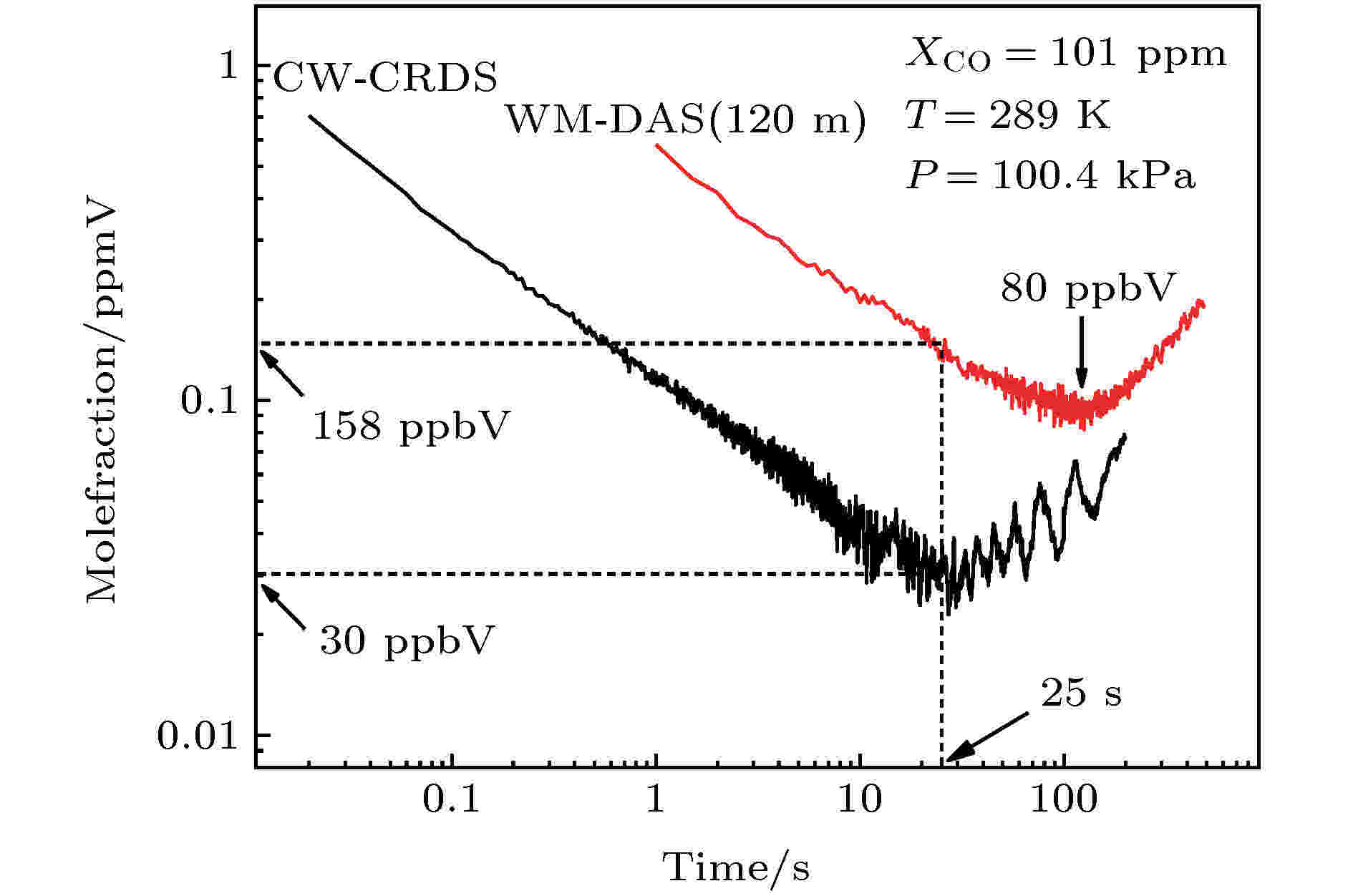全文HTML
--> --> -->尽管DAS在气体参数测量和谱线参数标定等方面具有操作简单、物理概念清晰等优点, 但诸如“振动噪声”、“暗噪声”、“光噪声”和“比例噪声”等限制了DAS测量精度的进一步提高[12,13], 难以用于弱吸收条件(如气体浓度低、谱线强度弱等)气体参数或谱线光谱常数的高精度测量. 为此, 科研工作者常采用延长有效吸收光程的方法以提高气体分子对激光的吸收作用[14-19], 进而提高吸收率函数的测量信噪比. 基于几何光学的Herriott[14-17]和White[18,19]等多次反射池通过增加激光反射次数延长吸收光程, 如反射100次即可将10 cm长吸收池的有效吸收光程提高到10 m左右, 在痕量气体监测、弱吸收谱线参数标定等领域得到广泛应用. 与此同时, 为进一步提高吸收率函数的测量精度, 科研工作者进行了诸多研究, 如采用稳定光强的方法以减小光强波动对吸收率函数测量的影响[20], 或采用基于物理光学的腔增强吸收光谱[21-23]或连续波腔衰荡光谱(CW-CRDS)[24-26]将有效吸收光程提高到数km以上, 但该类方法对环境要求高, 系统操作复杂.
与上述延长吸收光程、稳定光强等研究方法不同, Du等[27]将波长调制光谱(WMS)谐波分析思想引入到DAS中, 通过傅里叶变换中特征频谱复现分子吸收率函数, 即波长调制-直接吸收光谱法(WM-DAS). 该方法融合了DAS (免标定、可测量吸收率函数)和WMS (高信噪比、抗干扰能力强)的优点, 将吸收率函数测量信噪比提高了约1个量级, 其拟合残差标准差低至约1 × 10–5量级[28,29]. 该方法可高精度标定分子谱线的光谱常数, 如碰撞展宽系数、温度指数、线强度等, 即使在弱吸收条件下仍能测得吸收率函数的精细结构, 可实现高精度的Rautian[30]和Galatry[31]线型函数中的Dicke收敛系数、Speed-dependent Voigt[32]线型函数中的速度依赖的碰撞展宽系数等参数的精确测量.
考虑到WM-DAS的优点, 本文利用高信噪比的WM-DAS方法结合长光程Herriott池, 在室温低压条件下, 对CO分子1567 nm处R5—R11近红外弱吸收谱线(约2 × 10–23 cm–1/(mol·cm–2))的吸收率函数进行了高精度复现, 同时根据测得的吸收率函数标定了谱线碰撞展宽、Dicke收敛和速度依赖的碰撞展宽等系数, 并将测量的吸收率函数、标定的光谱参数及其不确定度与高灵敏度的CW-CRDS测量结果进行了比较.
 图 1 WM-DAS与CW-CRDS的系统原理图(LC, 激光电流和温度控制器; FI, 光纤隔离器; AOM, 声光调制器; APD, 雪崩光电二极管; PD, 光电二极管; DDG, 数字延迟发生器; PZT, 压电换能器; WM, 波长计)
图 1 WM-DAS与CW-CRDS的系统原理图(LC, 激光电流和温度控制器; FI, 光纤隔离器; AOM, 声光调制器; APD, 雪崩光电二极管; PD, 光电二极管; DDG, 数字延迟发生器; PZT, 压电换能器; WM, 波长计)Figure1. System schematic diagram of WM-DAS and CW-CRDS. LC, laser current and temperature controller; FI, fiber isolator; AOM, acousto-optic modulator; APD, avalanche photodiode; PD, photodiode; DDG, digital delay generator; PZT, piezoelectric transducer; WM, wavelength meter.
衰荡腔(腔长约0.5 m)由一对高反射率(反射率高于99.99%)镜片组成. 通过PZT扫描腔长, 使腔长扫描范围大于一个自由光谱区, 以确保任意波长的激光均可耦合进腔内. 腔另一端的出射光由光电探测器接收, 当探测器达到预设触发电平时, 由数字延迟发生器发送脉冲信号, 使声光调制器失去能量, 从而关闭进入腔内的激光以形成单指数衰减信号. 采用高速数据采集卡同时采集脉冲信号和单指数衰减信号, 并利用计算机对实验数据实时处理, 快速拟合[24]得到衰荡时间. 采用步进式扫描激光电流来改变激光波长, 从而得到随波长改变的衰荡时间τ(v), 采集多个扫描周期并平均以提高信噪比. 随后, 通过公式

其中Voigt线型(VP)可以表示为[27-30]







 图 2 测量的100个正弦波周期的激光光强及激光相对波长标定结果(FSR为自由光谱范围), 以及蕴含气体吸收率函数信息的透射光强傅里叶变换(FFT)系数
图 2 测量的100个正弦波周期的激光光强及激光相对波长标定结果(FSR为自由光谱范围), 以及蕴含气体吸收率函数信息的透射光强傅里叶变换(FFT)系数Figure2. Measured transmitted intensities of 100 periods of sinusoidal waves and fitted frequency (FSR, free spectral range), and fast Fourier transform (FFT) coefficients Ak and Bk of transmitted light intensity.
图3(a)展示了WM-DAS方法对R10谱线的测量结果, 为便于与CW-CRDS比较, 将WM-DAS所测吸收率(α)转换为吸收系数(κ). CW-CRDS方法采用步进式扫描激光波长, 间隔约0.002 cm–1, 扫描范围约0.4 cm–1, 共扫描100次, 用时约20 min. 图3(b)展示了CW-CRDS测量结果, 由于测量的吸收系数仅与衰荡时间相关而与光强无关[24-26], 残差波动小, 测量数据更加平滑, 可以清晰看出VP拟合残差中“w”形的精细结构, 其原因在于VP未考虑Dicke收敛效应[31,32], 观察到该精细结构也说明了CW-CRDS具有很高的灵敏度. 与此相比, WM-DAS通过提取周期性正弦信号的整数倍特征频谱来复现气体吸收光谱, 可有效减小或消除振动、电磁等多种噪声干扰[12,13], VP拟合残差中也可清晰地观察到“w”形的精细结构, 这验证了本文WM-DAS测量结果与CW-CRDS相一致. 与VP不同, RP考虑了Dicke收敛效应, 拟合时可以消除“w”形残差. 从RP拟合结果可知, WM-DAS和CW-CRDS两种方法测得的吸收率函数拟合残差标准差相差约2.5倍, 相应的SNR(1σ)相差约2.5倍, 但WM-DAS的测量时间(0.1 s)远小于CW-CRDS (20 min), 在大量的谱线参数标定以及工业现场的气体快速监测中更有优势.
 图 3 测量的CO光谱及其最佳Voigt和Rautian线型拟合结果(XCO, c, τ和σSD分别为CO浓度、光速、衰荡时间和残差的标准差) (a) WM-DAS; (b) CW-CRDS
图 3 测量的CO光谱及其最佳Voigt和Rautian线型拟合结果(XCO, c, τ和σSD分别为CO浓度、光速、衰荡时间和残差的标准差) (a) WM-DAS; (b) CW-CRDSFigure3. Measured absorption function of CO and the best fits of Voigt and Rautian profile (XCO, c, τ, and σSD represent the CO concentration, light velocity, ring down time and standard deviation of the residual, respectively): (a) WM-DAS; (b) CW-CRDS.
为了进一步验证WM-DAS的测量精度, 利用该方法对不同压力下CO分子R5—R11谱线的光谱参数进行了测量, 并与CW-CRDS测量结果进行对比, 其中, 碰撞展宽(γc)及速度依赖的碰撞展宽(γ2)选用SDVP[33,34]的拟合结果, Dicke收敛(β)选用RP[31,32]的拟合结果. 气体温度为288 K, 温度波动小于0.3 K, CO浓度为0.5% (背景气为N2), 压力范围1—25 kPa. 图4(a)和图4(b)给出了不同压力下, 两种方法对CO分子R10谱线的γc及γ2和β测量结果, 测量数据的拟合线性度分别达到0.9998 (γc)和0.98 (γ2和β), 这说明两方法测量数据有较好的一致性. 在上述参数中, β和γ2数值远小于碰撞展宽γc, 对光谱信噪比有较高的要求, 因而其测量误差略大于γc. 事实上, 虽然WM-DAS的SNR低于CW-CRDS的SNR, 但是WM-DAS测量速度更快测量点更多, 每个测量点仅需1 s (信号采集和数据处理), 测量过程受环境温度、气压波动影响更小, 因而β和γ2的线性拟合结果与CW-CRDS相一致.
 图 4 不同压力下测得的光谱参数(WM-DAS为红色, CW-CRDS为黑色) (a) γc (圆); (b) β (正方形), γ2 (三角)
图 4 不同压力下测得的光谱参数(WM-DAS为红色, CW-CRDS为黑色) (a) γc (圆); (b) β (正方形), γ2 (三角)Figure4. Measured spectral parameters for various pressures (WM-DAS (red), CW-CRDS (black)): (a) γc (dot); (b) β (square), γ2 (triangle).
表1列出了WM-DAS和CW-CRDS两种方法采用四种线型(VP, GP, RP, SDVP)拟合得到的碰撞展宽系数γ0(T0), Dicke收敛系数β0(T0)和速度依赖的碰撞展宽系数γ2(T0). 测量不确定度主要来源于气体温度(< 0.2 K)、压力(< 30 Pa)、浓度(< 50 ppm)以及吸收率函数拟合误差, 经计算得到γ0(T0)总的不确定度范围约为0—1% (CW-CRDS)和0—1.5% (WM-DAS). 其中, 两种方法采用VP拟合的γ0(T0)的相对误差均不超过1%, 采用精度更高的RP/GP/SDVP拟合的γ0(T0)的相对误差仅略大于1%, 主要是由Dicke收敛系数及速度依赖的碰撞展宽系数的拟合不确定引起的. 由于β0(T0)和γ2(T0)值比γ0(T0)小, 对光谱信噪比要求更高, 因此CW-CRDS测得的β0(T0)和γ2(T0)的不确定度范围为5%—15%, 与文献[35]的测量结果0.7%—14%相接近. 相比之下, WM-DAS通过提取特征频率复原吸收率函数, 并通过快速测量大量的数据点来降低不确定度, β0(T0)和γ2(T0)不确定度范围达到10%—20%.
| v0/cm–1 | Transition | E′′/cm–1 | ? | γ0(T0)/10–2 cm–1·atm–1 | β0(T0)/10–2 cm–1·atm–1 | γ2(T0)/10–2 cm–1·atm–1 | ||||||
| CRDS | WM | HT | CRDS | WM | CRDS | WM | ||||||
| 6371.299 | R5 | 57.670 | VP | 6.26b | 6.23b | 6.29a | — | — | — | — | ||
| GP | 6.43b | 6.48b | 2.84c | 2.90d | — | — | ||||||
| RP | 6.47b | 6.50b | 2.57c | 2.67d | — | — | ||||||
| SDVP | 6.50b | 6.55b | — | — | 0.87c | 0.77d | ||||||
| 6374.406 | R6 | 80.735 | VP | 6.10b | 6.08b | 6.12a | — | — | — | — | ||
| GP | 6.20b | 6.30b | 2.65c | 2.71d | — | — | ||||||
| RP | 6.25b | 6.30b | 2.38c | 2.46d | — | — | ||||||
| SDVP | 6.26b | 6.36b | — | — | 0.69c | 0.73d | ||||||
| 6377.407 | R7 | 107.642 | VP | 5.97b | 5.94b | 5.99a | — | — | — | — | ||
| GP | 6.07b | 6.12b | 2.22c | 2.48d | — | — | ||||||
| RP | 6.10b | 6.17b | 2.06c | 2.36d | — | — | ||||||
| SDVP | 6.25b | 6.24b | — | — | 0.71c | 0.71d | ||||||
| 6380.301 | R8 | 138.390 | VP | 5.89b | 5.88b | 5.89a | — | — | — | — | ||
| GP | 6.04b | 6.02b | 2.20c | 2.27d | — | — | ||||||
| RP | 6.06b | 6.09b | 2.14c | 2.14d | — | — | ||||||
| SDVP | 6.11b | 6.15b | — | — | 0.70c | 0.64d | ||||||
| 6383.090 | R9 | 172.978 | VP | 5.80b | 5.78b | 5.80a | — | — | — | — | ||
| GP | 5.91b | 6.03b | 2.08c | 2.11d | — | — | ||||||
| RP | 5.94b | 6.03b | 1.89c | 1.85d | — | — | ||||||
| SDVP | 5.97b | 6.09b | — | — | 0.61c | 0.63d | ||||||
| 6385.771 | R10 | 211.404 | VP | 5.72b | 5.68b | 5.73a | — | — | — | — | ||
| GP | 5.91b | 5.89b | 2.27c | 2.29d | — | — | ||||||
| RP | 5.92b | 5.91b | 1.98c | 1.86d | — | — | ||||||
| SDVP | 5.98b | 5.96b | — | — | 0.62c | 0.65d | ||||||
| 6388.347 | R11 | 253.667 | VP | 5.62b | 5.58b | 5.67a | — | — | — | — | ||
| GP | 5.91b | 5.80b | 2.62c | 2.21d | — | — | ||||||
| RP | 5.93b | 5.82b | 2.15c | 2.00d | — | — | ||||||
| SDVP | 5.95b | 5.89b | — | — | 0.77c | 0.67d | ||||||
| 注: WM代表WM-DAS, HT表示HITRAN[36];a表示相同温度(T0 = 288 K)下HITRAN的数据, 空气为背景气;b不确定度 0—1%;c不确定度 5%—15%;d不确定度 10%—20%. | ||||||||||||
表1WM-DAS和CW-CRDS测量的光谱参数及其不确定度
Table1.Measured spectroscopic parameters and uncertainties.
为了进一步评价WM-DAS和CW-CRDS两种方法的测量下限, 在相同条件下, 分别对WM-DAS和CW-CRDS进行了Allan方差[37]分析, 实验结果如图5所示. 其中CW-CRDS采用固定中心波长的测量方式, 积分时间约25 s时(固定波长下的衰荡时间采集速度约为0.01 s, 25 s相当于平均2500次), 基于CW-CRDS的CO检测限可到30 ppb (

 图 5 两种方法测量的Allan方差
图 5 两种方法测量的Allan方差Figure5. Allan variance measured by the two methods.
